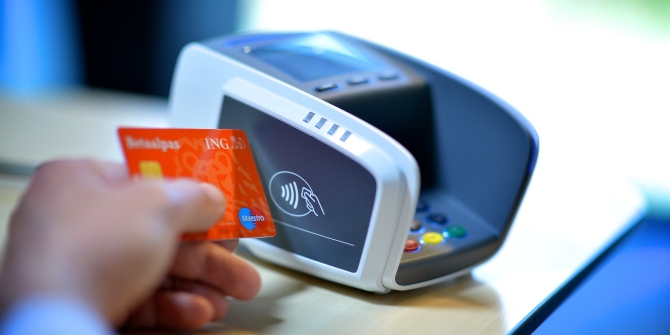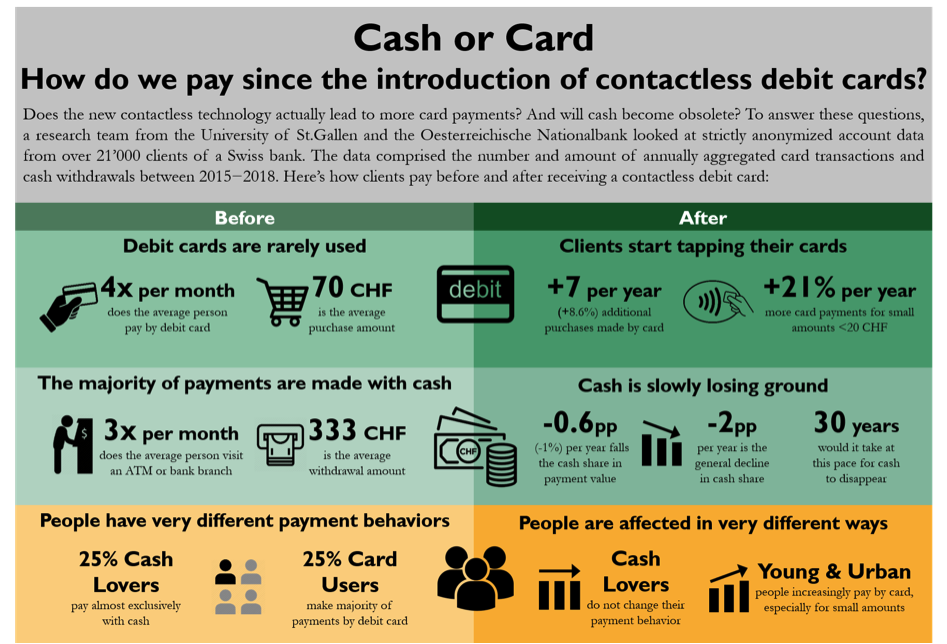
Cash still accounts for a significant share of payment transactions in most advanced economies (Bagnall et al. 2016). However, it is a widely held presumption that the recent innovations of contactless, mobile and instant payments will accelerate the move to a cashless society. This would pose challenges to central banks who have a mandate to guarantee a safe, efficient and broadly accessible payment system. To counterbalance ongoing payment innovations and an expected strong decline in cash demand – as has been observed e.g. in Sweden – many central banks are now contemplating the introduction of electronic cash substitutes, i.e. central bank digital currencies.
But are recent digital payment innovations really accelerating the move to a cashless society? And will cash therefore become obsolete? To answer these questions, a research team from the University of St. Gallen and the Oesterreichische Nationalbank examined bank-account data for a random sample of over 21,000 customers of a Swiss retail bank. To ensure anonymity, all identifying client information was removed and the transactions aggregated on a yearly basis. The data covers all client transactions and cash withdrawals between 2015 and 2018. This is an interesting period, because starting 2016, the bank rolled out contactless debit cards to clients as their existing card expired.
This setting constitutes a “natural experiment” that allows us to isolate the causal effect of the new payment technology on customers’ payment behaviour. The bank issues new debit cards at year-end, thus we could divide the clients in three groups: early adopters received a new contactless-enabled debit card at the end of 2016, Late adopters at the end of 2017 and non-adopters only at the end of 2018, which is outside of the observation period. Because expiry dates are random, the three groups are very similar with regard to socio-demographic characteristics such as gender, age or income and their payment habits and money demand. Thus, any change in behaviour after receiving the new debit card can be attributed to the contactless function.
Figure 1. Cash or card?

Cash still rules…
By 2018, the majority of everyday payments by value were still conducted in cash – although all clients in the sample had a debit card. The average customer visited an ATM three times a month to withdraw on average 333 Swiss Francs (275 £). By comparison, the average customer paid only four times per month by debit card for an average amount of 70 Swiss Francs (58 £). Cash is losing ground slowly; its value share in payment fell from 2015 to 2018 by about two percentage points a year. Continuing at this pace it would take another 35 years for the average Swiss consumer to ditch cash completely.
…but consumers do start tapping
The results confirm that debit cards are used more often if they feature the contactless function. After receiving a contactless card, clients made on average seven additional purchases by card per year (+8.6% relative to the sample mean of 79 transactions). The increased card use is most pronounced for small, PIN-exempt payments.
As we observe debit card transactions by amounts, we can test whether contactless cards trigger increases in (contactless) debit card payments also for amounts above 40 Swiss Francs (33 £) for which a PIN is still necessary. The results suggest that these spillover effects are present for payment amounts beyond the PIN-free threshold, although they are considerably weaker than for smaller payment amounts.
Contactless cards do reduce the overall cash share of payments, but only by an additional 0.6 percentage points per year (on top of the two percentage points trend decline). At this pace, even with a contactless card the average Swiss consumer would take 30 years to stop using cash entirely. Why isn’t the impact on cash use bigger? Most additional card payments that are triggered by the availability of contactless cards are small ticket items and make up only a negligible portion of total spending. Therefore, it isn’t surprising that we find no causal effect on cash demand, i.e. the average size or frequency of withdrawals.
It might be a long way to the cashless society
Our results suggest that it still might be a long way to a cashless society – even when considering that the trend decline in cash use might accelerate. This conjecture applies to those economies where cash is still much used like Germany, Switzerland, Austria or several other European countries (Esselink and Hernandez, Deutsche Bundesbank, Swiss National Bank). For consumers in countries that are much less cash-loving than Switzerland, like the UK, Sweden or Canada, these high cash use rates might be a reminiscence. However, our results also document significant and persistent heterogeneities in payment choice across consumers, which points towards the importance of habit and/or behavioural motives. We conjecture that such persistent behaviour may also apply to specific socio-demographic subgroups (e.g. older cohorts) in countries were cashless payments are more prevalent.
Corona and the threshold for contactless payments
During the ongoing coronavirus pandemic many countries have raised the limits for contactless payments. Our results do not allow us to make evidence-based predictions about the (permanent) impact of these policies on payment behaviour. However, our evidence does show that card payments increase mostly among those consumers who already use cards and only marginally for cash-lovers. We may therefore expect a similar effect of increased thresholds for contactless payments: Existing card users may substitute contactless card payments for conventional ones up to the new PIN-exempt amounts, while cash lovers may tend to stick to their coins and notes.
Authors’ disclaimer: The findings, interpretations and conclusions presented in this article are entirely those of the authors and should not be attributed in any manner to the Oesterreichische Nationalbank or the Eurosystem.
♣♣♣
Notes:
- Based on “Financial Innovation, Payment Choice and Cash Demand – Causal Evidence from the Staggered Introduction of Contactless Debit Cards”.
- This post expresses the views of its author(s), not the position of LSE Business Review or the London School of Economics.
- Featured image by ING Nederland, under a CC-BY-SA-2.0 licence
- When you leave a comment, you’re agreeing to our Comment Policy
 Martin Brown is professor of banking at the University of St. Gallen. His research and teaching is focused on financial intermediation and household finance.
Martin Brown is professor of banking at the University of St. Gallen. His research and teaching is focused on financial intermediation and household finance.
 Nicole Hentschel is a PhD student and research assistant at the chair of banking at the University of St. Gallen. Her research focuses on households’ financial and payment behaviour.
Nicole Hentschel is a PhD student and research assistant at the chair of banking at the University of St. Gallen. Her research focuses on households’ financial and payment behaviour.
 Hannes Mettler is an associate researcher with the Swiss Institute of Banking and Finance at the University of St. Gallen.
Hannes Mettler is an associate researcher with the Swiss Institute of Banking and Finance at the University of St. Gallen.
 Helmut Stix is advisor in the economic research department at the Oesterreichische Nationalbank (Central Bank of Austria). His current research is focused on households’ financial behaviour as well as cash demand and payment innovations.
Helmut Stix is advisor in the economic research department at the Oesterreichische Nationalbank (Central Bank of Austria). His current research is focused on households’ financial behaviour as well as cash demand and payment innovations.





